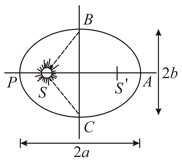Embibe Experts Solutions for Chapter: Gravitation, Exercise 4: BEGINNER'S BOX - 4
Embibe Experts Physics Solutions for Exercise - Embibe Experts Solutions for Chapter: Gravitation, Exercise 4: BEGINNER'S BOX - 4
Attempt the practice questions on Chapter 11: Gravitation, Exercise 4: BEGINNER'S BOX - 4 with hints and solutions to strengthen your understanding. Beta Question Bank for Medical: Physics solutions are prepared by Experienced Embibe Experts.
Questions from Embibe Experts Solutions for Chapter: Gravitation, Exercise 4: BEGINNER'S BOX - 4 with Hints & Solutions
If earth describes an orbit round the sun of double its present radius, what will be the year on earth ?
If the gravitational force were to vary inversely as power of the distance, then the time period of a planet in a circular orbit of radius around the sun will be proportional to:
A planet is revolving around the sun in an elliptical orbit. Its closest distance from the sun is . The farthest distance from the sun is . If the orbital angular velocity of the planet when it is nearest to the sun is , then the orbital angular velocity at the point when it is at the farthest distance from the sun is:-
The time period of revolution of moon around the earth is 28 days and radius of its orbit is 4 × 105 km.
If G = 6.67 × 10–11 Nm2/kg2 then find the mass of the earth.
Let the speed of the planet at the perihelion P in Fig. be vP and the Sun-planet distance SP be rp. Relate (rp, vP) to the corresponding quantities at the aphelion (rA, vA). Will the planet take equal times to traverse BAC and CPB ?

Asatellite moves in a circular orbit around the earth. The radius of this orbit is one half that of the moon’s orbit. Find the time in which the satellite completes one revolution.
A small satellite revolves round a planet in an orbit just above planet’s surface. Taking the mean density of planet as , calculate the time period of the satellite.
An object weighs at the North Pole of the earth. In a geostationary satellite distant from the centre of the earth (of radius ), the true weight and the apparent weight are, respectively,
